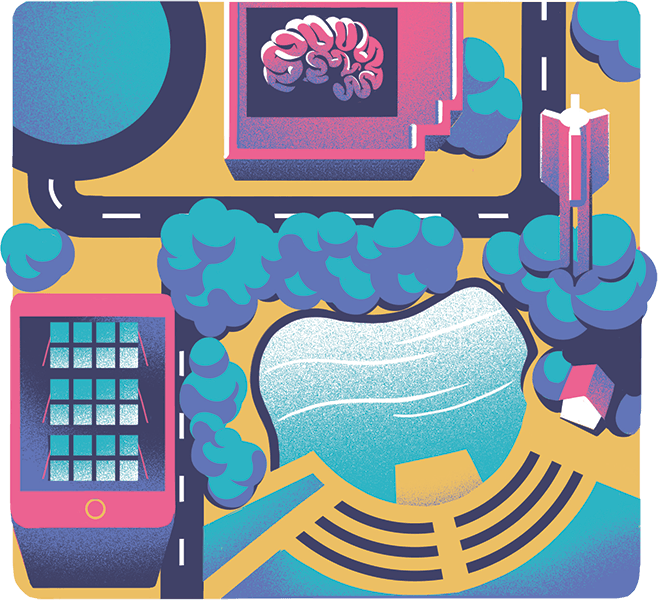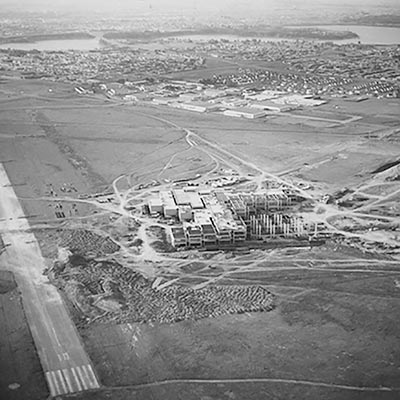
CAMPUS MASTER PLAN
Mount Royal’s infrastructure of physical, civil and digital networks are all inter-connected with accessibility in mind.
Spring/Summer 2017 issue
With the opening of the Taylor Centre for the Performing Arts in 2015 and the completion of the Riddell Library and Learning Centre, in fall 2017, Mount Royal will have officially completed the mandates of the University’s first Campus Master Plan (CMP), published in 1999.
Over the past two years, a new CMP has been developed to guide the evolution of the campus for the next 20 to 30 years.
Getting to the point of completing one CMP and starting another has been no easy task, says Duane Anderson, vice-president of Administrative Services. When Anderson arrived at MRU 20 years ago, the grounds consisted solely of Kerby Hall and the main building of MRU’s Lincoln Park campus.Since then MRU has grown rapidly, with the addition of a number of new buildings including the Faculty of Arts (EA), Bissett School of Business (EB), Roderick Mah Centre for Continuous Learning (EC), Taylor Centre for the Performing Arts (ED), parkade, supplementary residences, an extension to the west wing (Recreation), an addition to the science wing and the soon-to-be completed Riddell Library and Learning Centre.
The original CMP was designed in two phases, with the first adding EA, EB and parts of EC. The second phase was the construction of the Taylor Centre for the Performing Arts and the Riddell Library and Learning Centre.
“The first CMP gave us that clear direction for the first 10 years of what we wanted to do, the placement of buildings and the reworking of the whole campus,” says Anderson.
The process to develop the new CMP has been a collaborative effort to further strengthen Mount Royal into an expansive system that can easily integrate with its surroundings. The once somewhat isolated campus is being more and more absorbed into its surrounds and the city’s infrastructure. The neighbouring Canadian Forces Base Calgary (decommissioned in 1998) is now Currie Barracks, a nearly complete residential community. Vacant lands along 50 Avenue S.W. are being transformed into the busy commercial hubs of the ATCO Business Park and the Westmount Corporate Campus. As the vitality and density of the area intensifies, it has become critical to connect with community members, local businesses and surrounding developers.
A team of CMP consultants led by DIALOG, the architectural firm responsible for the design of the Riddell Library and Learning Centre, are working with the internal campus community, as well as external stakeholders, including The City of Calgary.
“The greatest potential was the realization of a fully committed, community-integrated undergraduate university that becomes a campus of choice for national and international students. The MRU CMP really focused on the vision of a local, inclusive and progressive campus that concentrates on individual students,” says John Souleles, associate architect with DIALOG and CMP committee member.
The engagement process included a number of workshops and open houses to gather different perspectives. Participants discussed options such as aligning street networks, creating an inviting facade through new building designs and landscaping, and adding paths and trails within the campus that join with the broader community.
Witnessing expansion happening all around, Anderson and the CMP committee engaged users from around campus, including Canada Lands Corporation, which is overseeing the development of Currie Barracks.
“We want to build a seamless transition from Currie Barracks to campus. Richardson Way is a critical roadway and a physical barrier,” says Anderson. “We are working very closely with them as we talk to The City about what is going to happen.”
For vocal adversary to urban sprawl and local Ward 11 Coun. Brian Pincott, the Mount Royal campus must co-develop with the districts around it. He agrees the state of Richardson Way needs to change, saying that the 60 kilometre per hour speed limit and lack of street parking are obstacles, and agrees a revised concept could create more paths of connectivity between residential and commercial developments.
“You have to think of it as one neighbourhood,” Pincott says. “Look at all of the development happening within a five-minute walk of MRU … it’s the definition of smart growth. The recent completion of the Flanders Avenue overpass, the implementation of bike lanes and new transit upgrades are all in response to current, and planned, growth.”
“Hopefully in 20 years you can walk across Richardson Way and not realize you have walked onto campus,” says Anderson, “and there will be shops and restaurants to access.”
As well, according to Souleles, “The community integration will be felt 360 degrees around MRU through the provision of commerce on campus, leveraging the adjacent market housing and residences for families. The opportunities are there for employment, and really meaningfully integrating the social fabric around MRU.”
This can be achieved by transforming the University’s “ring road,” says Souleles, including narrowing vehicular corridors, lowering speeds, expanding pedestrian and bicycle circulation routes and incorporating more people-friendly landscaping. There will also be walkable links between structures providing even more possibilities for contacts, he says.
□
You belong here
The CMP is working to give local residents and workers access to amenities and opportunities on campus that will make them want to become regular visitors. The plan is to have community members more frequently use Recreation facilities, take in events at the Taylor Centre for the Performing Arts, sign up for Continuing Education courses, rent conference spaces and become regular visitors to the upcoming Riddell Library and Learning Centre.
David Docherty, president of Mount Royal University, would like to see the new CMP also give students more reasons to spend time on campus outside of classtime.
Docherty recalls earlier this year when he and his family came to see Chris Hadfield at the Bella Concert Hall. Before the event, they had dinner at the Spot On Kitchen and Bar, exactly one kilometre away. As it turned out, they were served by a varsity Cougar athlete.
“We need a lot more of that. How do we develop more occasions for our students to stick around?” says Docherty.
South of the border, they call this concept a “sticky campus.” Once students arrive, they want to stay.
“What if we had opportunities that linked to our programs?” suggests Docherty.
“We have one of the best interior design programs in the country, and the only one in Alberta. Wouldn’t it be neat if building designers opened up a business on campus and hired our students?”
Souleles sees the chance to develop distinct corridors called “precincts,” which would be laid out to establish niche neighbourhoods within the campus. Anderson believes a South Campus Precinct could be where commercial activity takes place. As funding is a continuous challenge, it would allow the University to look at other ways of generating revenue. Similar to Docherty’s thinking, these developments would leverage MRU’s programs and research, providing work opportunities for students.
For Docherty and Anderson, it’s about how to shape the campus to better serve everyone who uses it, and to make sure no space is underutilized.
“Our primary objective for the next five years is actually repurposing internal parts of the campus,” says Anderson.
With the Riddell Library and Learning Centre set to open, and the Taylor Centre for the Performing Arts already up and running, sections of Lincoln Park are ripe for re-envisioning. The focus is to enhance the student experience by creating a welcoming, centralized student services centre on Main Street, MRU’s main corridor.
“They (student services) are currently kind of spread out, so being able to bring all those critical services together in a really nice environment off Main Street and to be able to engage students while allowing them to access services efficiently is a priority,” Anderson says.
For vocal adversary to urban sprawl and local Ward 11 Coun. Brian Pincott, the Mount Royal campus must co-develop with the districts around it. He agrees the state of Richardson Way needs to change, saying that the 60 kilometre per hour speed limit and lack of street parking are obstacles, and agrees a revised concept could create more paths of connectivity between residential and commercial developments.
“You have to think of it as one neighbourhood,” Pincott says. “Look at all of the development happening within a five-minute walk of MRU … it’s the definition of smart growth. The recent completion of the Flanders Avenue overpass, the implementation of bike lanes and new transit upgrades are all in response to current, and planned, growth.”
“Hopefully in 20 years you can walk across Richardson Way and not realize you have walked onto campus,” says Anderson, “and there will be shops and restaurants to access.”
As well, according to Souleles, “The community integration will be felt 360 degrees around MRU through the provision of commerce on campus, leveraging the adjacent market housing and residences for families. The opportunities are there for employment, and really meaningfully integrating the social fabric around MRU.”
This can be achieved by transforming the University’s “ring road,” says Souleles, including narrowing vehicular corridors, lowering speeds, expanding pedestrian and bicycle circulation routes and incorporating more people-friendly landscaping. There will also be walkable links between structures providing even more possibilities for contacts, he says.
□
More to come
As outlined in the 2025 University Strategic Plan, Mount Royal’s goal is to increase the number of full-load equivalent (FLE) students to 13,000 from about 9,300 in 2015/16 in the next 10 years. That many more full-time students would almost certainly require another building; however, the type depends on what kind of programs the University will specialize in down the road.
“If we spend heavily in the sciences, then we would likely look to build a joint health and science area,” says Anderson. “That’s the early thinking, but it’s subject to what we as a University offer academically.”
As buildings are added, it’s inevitable that parking spots are removed. Gerry McHugh, director of Parking and Transportation Services, says that the University realizes space is limited and is working on solutions.
“Recent developments ... have made it clear that infrastructure on, and around, our campus must be a marriage of transportation needs — no matter how people want to come and go from the University.”
“The City is committed to accessibility through a comprehensive approach,” says Pincott. “It’s not sustainable to expect people to keep driving to, and from, the area.”
Depending on available space, the University could potentially accommodate close to 20,000 FLE students. This, of course, is all subject to how Calgary continues to grow, but Mount Royal is poised to accommodate.
“We are already a miniature city,” says Anderson. “We have our own roads and our own people taking care of maintenance and security. The long-term plan is to better provide what this corner of the city is really looking for.”
The CMP committee has noted the prospects of the existing playing fields as being part of a Health and Wellness Precinct, providing enhanced recreational facilities.
“A field house would suit this need,” says Anderson, which would be a pivotal step towards Mount Royal being able to have a varsity football team.
“This is the vision for what we can do, and athletics is a big piece of it all,” he adds. “The main soccer field is actually the proper dimensions for football. It was built that way because the people of the day thought maybe one day we would have a team.”
The Riddell Library and Learning Centre is already set to serve as a cultural precinct.
“The new facility will have a Speaker’s Corner and many interactive opportunities for the public,” says Anderson.
An East Campus Precinct will also be considered for extra partnering activities.
“A health clinic could be used by the public, and also by our students for work placements. It’s an exciting time to be a university,” says Anderson.
Mount Royal is in a great position — literally and figuratively — to continue to evolve into a community that is vibrant throughout the day, into the evening and at all times of the year. The campus’s expansion plans will offer the full range of amenities, services, spaces, opportunities and experiences that are expected of a growing post-secondary institution.
As the campus develops, what do you see?
We asked Mount Royal President David Docherty and Vice-President of Administrative Services Duane Anderson for their predictions.

David Docherty
How do you see the campus developing in the next 10 to 20 years?
Hopefully to a pedestrian-friendly campus, with lots of access points and lots of places to hang out outside.
Cost aside, what would you add?
Indigenous student and family residences. That’s a priority of mine, and seeing that come to fruition would be great.
Best hidden gem?
The Wyatt organ room is really cool! Where the sundial is between the T-wings is really neat, too.

Duane Anderson
What’s the best addition in your 20 years here at Mount Royal?
I have the grey hair to prove it! The Taylor Centre for the Performing Arts is an exceptional building. It's spectacular.
Cost aside, what would you add?
I would build commercial main floor opportunities on the east side of campus along Richardson Way so we can get closer to the outside community.
Best hidden gem?
The grounds and pond, we don’t use those enough. That's part of the work we are doing right now with the new CMP.



